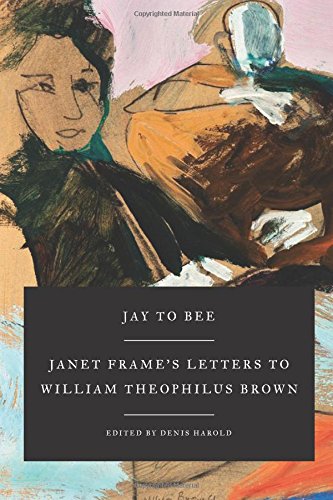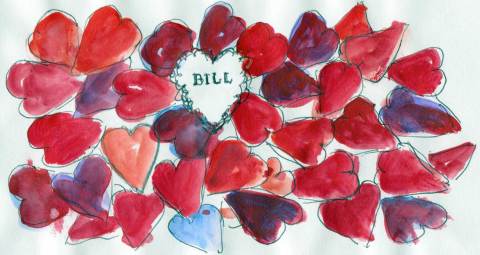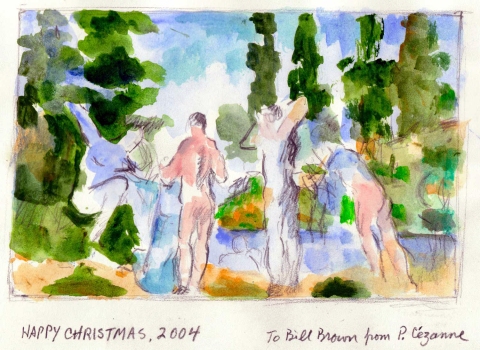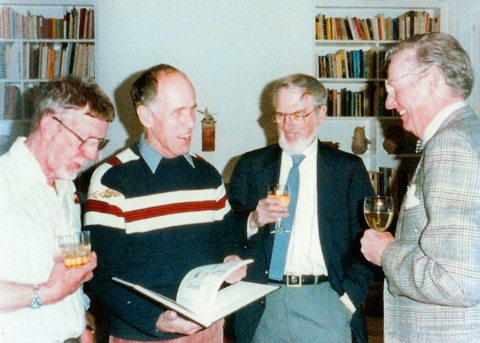The Birth of Bay Area Figuration
June 23, 2023 § 1 Comment

IN 1952, while studying for their master’s degrees in art, Paul Wonner and Theophilus Brown met at the University of California, Berkeley.
After graduating, they found studio space on Berkeley’s Shattuck Avenue, a building they shared with Richard Diebenkorn, David Park and Elmer Bischoff, among others, who met there for drawing sessions. From this creative association came the movement that became known as Bay Area Figuration (or the Bay Area Figurative Movement) in which recognizable subject matter and the gestural bravura of Abstract Expressionism co-existed.
It was the first contemporary artistic movement that achieved recognition in the United States and abroad that originated in California.
REVIEW: “Making the rules“

‘This may be my best painting’
June 6, 2023 § Leave a comment

By MATT GONZALEZ
I first met Paul Wonner and Bill Brown in the early 2000s at the San Francisco home of the gallerist Charles Campbell and his artist wife, Glenna.
I particularly enjoyed watching Bill and Paul look at their own paintings, which hung in the Campbells’ Potrero Hill home. Charlie and Glenna had a wonderful collection, which included their Bay Area Figurative associates, including Richard Diebenkorn, David Park, Joan Brown, Manuel Neri, Elmer Bischoff, Wayne Thiebaud and Nathan Oliveira. There was something about the way that Bill and Paul studied their own paintings that seemed as if they were discovering them for the first time.
Once when I was with Paul and Charlie in the living room, among a Neri plaster and paintings by Frank Auerbach and Thiebaud, Paul was staring intently at one of his own paintings, his 1961 Nude with Indian Rug. I was anticipating his disapproval when he said, “This may be my best painting.” Charlie was so excited that he went over to the kitchen, asked Glenna and Bill to join us, and made Paul repeat the remark. Whether the wine had already gotten to him, I do not know, as Paul made too many fine paintings in my estimation to call any one of them his best. However, there was in his comment an excitement about engaging with a work from another era. We all enjoyed a hearty toast to the sentiment.
— excerpted from Breaking the Rules: Paul Wonner and Theophilius Brown, a catalog for the exhibition of the same title at the Crocker Art Museum in Sacramento, which continues through August 27.
A letter from de Kooning
October 24, 2021 § Leave a comment

THE GREAT Bay Area Figurative painter William Theophilus Brown recalled that one of his professors at UC Berkeley in the early 1950s was not impressed with the new student from New York — until a letter arrived.
He took a dim view of me. I remember he made fun of me the first semester. I was painting on a peel-off palette, and my brushes weren’t big enough. I don’t know. He laid it on me. And then I got a case of poison oak. Being an eastern boy, I knew ivy but not oak. And it started on my forehead and worked its way down non-stop to my feet. So I was out eight weeks. And I knew I would flunk the course. However, Elaine de Kooning wrote me a letter, and she didn’t have my address so it was just Bill Brown, Art Department, and it was pinned on the bulletin board in the hallway. And it just said de Kooning, it didn’t say Elaine. So when I came back, he came over right away to me and he said, “Do you really know de Kooning?”
— From an interview with Paul Karlstrom for the catalog of the 2011 exhibition, “Theophilus Brown: An Artful Life,” at the Thomas Reynolds Gallery in San Francisco.
Wonner-Brown estate to the Crocker
March 30, 2019 § Leave a comment
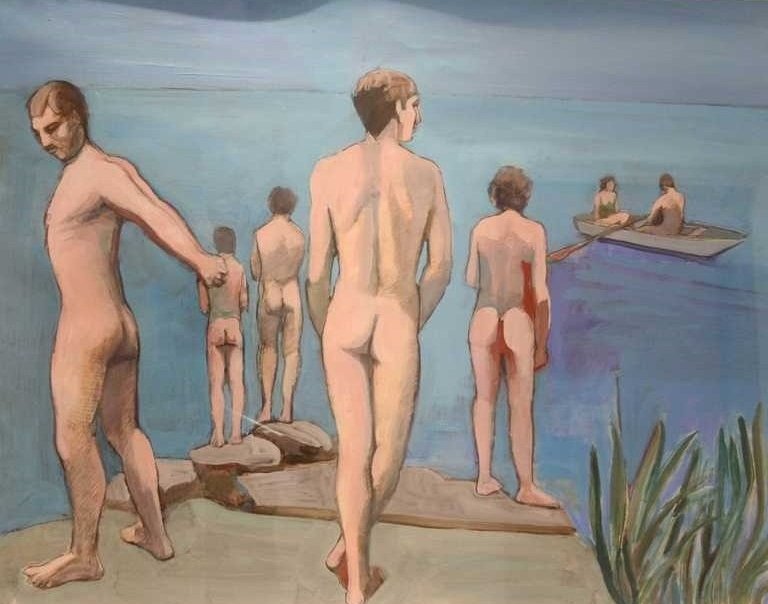
William Theophilus Brown | Standing Bathers (1993)
THE CROCKER ART MUSEUM in Sacramento has received more than 1,800 works of art by Paul Wonner and William Theophilus “Bill” Brown and established the Paul Wonner and William Theophilus Brown Endowment Fund.
In accordance with the artists’ wishes, the fund will support museum projects relating to emerging artists or lesbian, gay, bisexual, transgender, queer, or questioning and intersex artists.
By 2023, the Crocker Art Museum will use the fund to mount an exhibition of the work of Wonner and Brown — the most comprehensive show of the artists’ body of work ever presented — and produce an accompanying catalogue.
“Paul Wonner and Bill Brown were trail blazers, both individually and as a couple,” said the museum’s associate director and chief curator, Scott A. Shields. “It is wonderful that their legacy will live on, not only through their own art, but though their forward-looking support of other artists. It is what they wanted, and everyone at the Crocker is honored to be able to realize their vision.”
Read more from the Crocker Museum
Jay to Bee
August 1, 2016 § Leave a comment
IN 1951, just days before her scheduled lobotomy after years in a mental hospital, New Zealand author Janet Frame’s first collection of short stories unexpectedly won the Hubert Church Memorial Award, one of the country’s most prestigious honors. The procedure was cancelled, and Frame would go on to become one of the seminal authors of contemporary New Zealand literature.
During her time at the MacDowell artist’s colony in New Hampshire, Frame met painter William Theophilus Brown, and their friendship resulted in a whimsical and artistic correspondence that lasted until Frame’s death in 2004. A new book, Jay to Bee: Janet Frame’s Letters to William Theophilus Brown, captures their moving and enlightening correspondence.
MORE: “Jay to Bee“
‘That’s how we met’
May 16, 2012 § Leave a comment
William Theophilus Brown — Bill to his friends — and Paul Wonner met as graduate art students at Berkeley in 1952. Their partnership endured. “He was my best critic,” said Brown, “and I think I was his.”
In a conversation with Paul Karlstrom of the Smithsonian Institution in 2011, Brown recalled when they met.
WTB: I came out to California because I wanted to try to find out a little more about who I was. And I knew nobody in California. I knew the Stravinskys, but they were in Los Angeles. And so I decided to go to graduate school at Berkeley and get a degree so I would be able to teach. And I did. And I came out in the fall three days before classes began and signed up. And Paul Wonner was in three out of four classes the first semester.
That’s how you two met?
That’s how we met. Well, we met, but he thought I was such a snob that he didn’t really speak to me very much.
He got over it. How?
He got over it. I didn’t change. Anyway, it took a while, but then I could see from my point of view that Paul was the best painter among the students and also the faculty. So we did get together then.
How old was he relative to you?
I think he was about two or three years younger.
Because you were together a very long time. When did you become a couple?
I think by the end of that first year. We were together 50 years. He was my best critic and I think I was his best critic. We really trusted each other. And, well, I thought he was a marvelous man. Still do.
Art, music — and good Scotch
April 20, 2012 § 1 Comment
The artist Theophilus Brown was also a talented musician from an early age and a music major at Yale. Throughout his long life he played the piano with dedication and talent, often accompanied by a violinist, and even recorded some of his original compositions. He was still at the piano the day before he died at age 92 on February 8, 2012.
His beloved Steinway grand piano has been donated to the San Francisco Towers, the senior home where he lived during his last decade, which he called “the Versailles of retirement homes.” A memorial recital was performed on his piano in the grand salon of the Towers on April 21, 2012. Friends have proposed an annual recital in his memory to spotlight rising stars in the music world.
An opening reception for a new exhibition of his work at the Thomas Reynolds Gallery followed, along with a single-malt Scotch tasting. The gallery hosted an earlier tasting of single-malt — Brown’s drink of choice — on his 90th birthday. “Life is too short for cheap white wine,” he said at the time.
The exhibition, “Theophilus Brown: A Celebration,” is drawn entirely from paintings, drawings and collages in his apartment and studio at the time of his death. It includes his collection of drawings by his partner, Paul Wonner, another key member of the Bay Area Figurative group.
At his memorial, an excerpt from a forthcoming documentary on Theophilus Brown was played, giving the great man himself the final word.
Coming soon: “Theophilus” the film
Remembering Theophilus Brown
April 19, 2012 § Leave a comment
By JOHN SEED
The Huffington Post
At the age of 11, William Theophilus Brown shook the hand of the artist Grant Wood, the creator of American Gothic, who was awarding him third prize in a juried adult art competition. “He (Wood) was amazed to see this kid walking up the aisle,” Brown later recalled. In the long and richly artistic life that followed Brown racked up interesting life experiences, meeting many more “gods and idols” along the way.
Part of Brown’s success in life seems to have stemmed from always knowing just what to do or say. One day in Europe, for example, he recognized the man knocking at a friend’s studio door as Alberto Giacometti, and immediately set up an easel and invited Giacometti to draw the model with them.
Kissed by de Kooning
February 22, 2012 § Leave a comment
“Words are one language and painting is another.” Excerpts from an interview with William Theophilus Brown conducted on October 26, 2011, by Paul Festa.
The last supper
February 18, 2012 § Leave a comment
“I took him 36 oysters Saturday night and we shared dinner,” Theophilus Brown’s friend Matt Gonzalez said. “He had a good appetite and was in good spirits. But he couldn’t leave the apartment, and he was clear that if he couldn’t go to his studio and make art anymore, he didn’t want to live. So it was time.”
EARLIER: “A friendship with Theophilus Brown“
